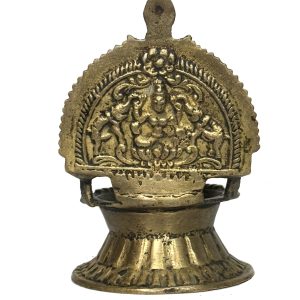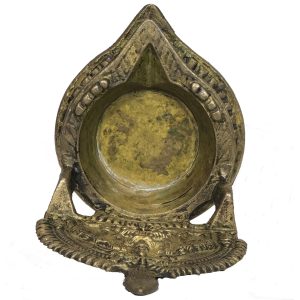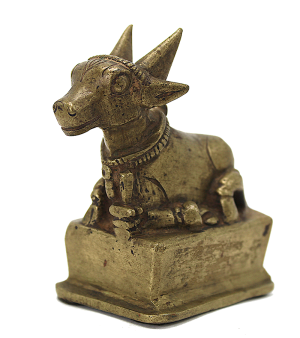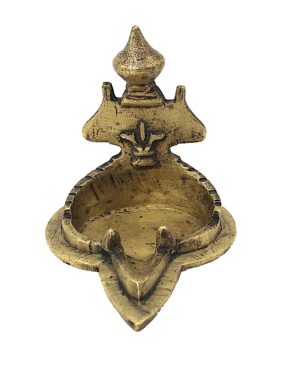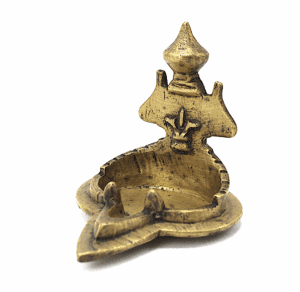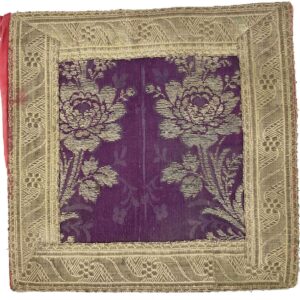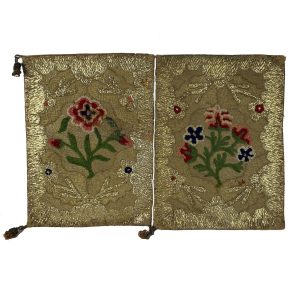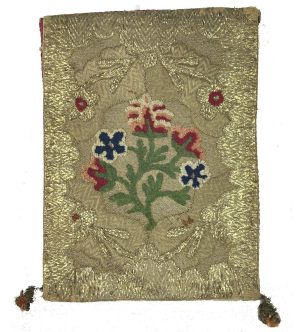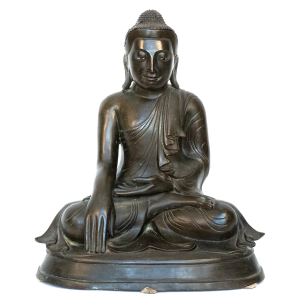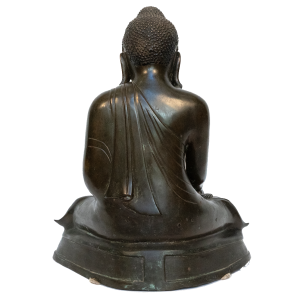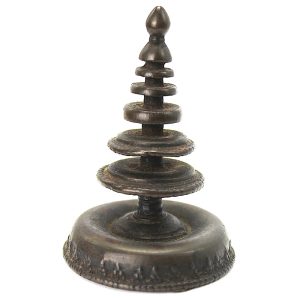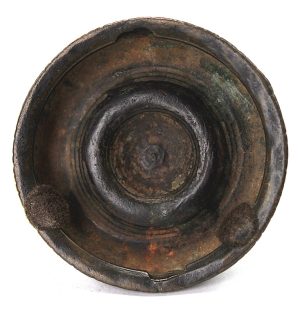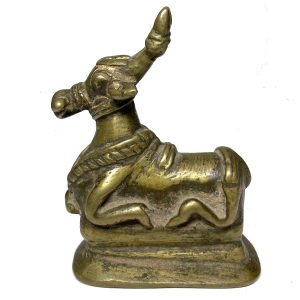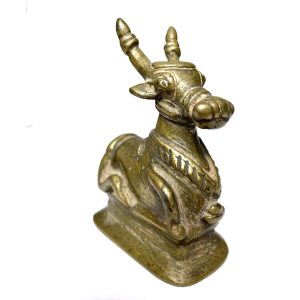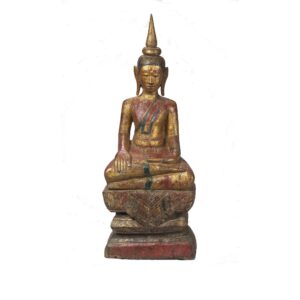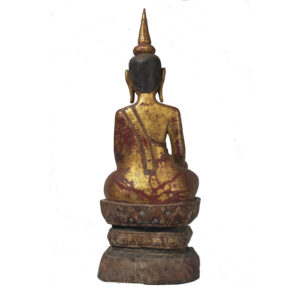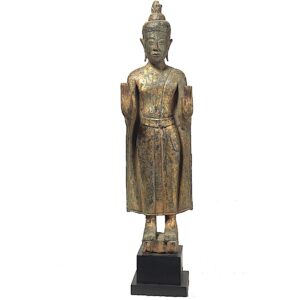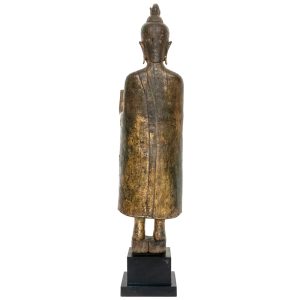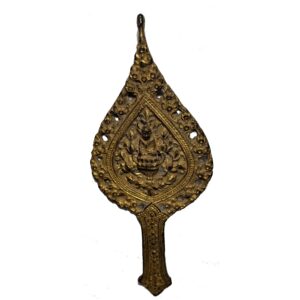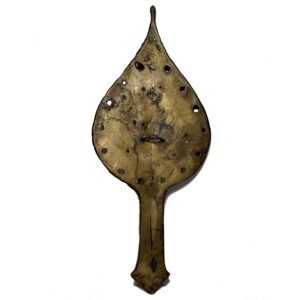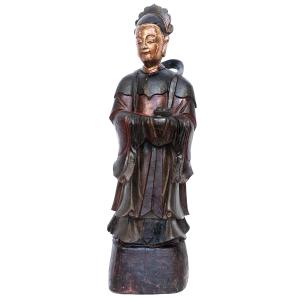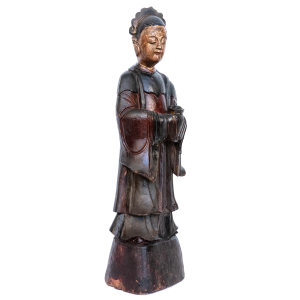Showing 13–24 of 248 results
-
Sale!


$150.00 Original price was: $150.00.$120.00Current price is: $120.00.
H: 5″ W: 3.25″ D:3.875″ | FREE SHIPPING WITHIN CONTINENTAL U.S.
Brass oil lamp front and back Lakshmi on a lotus, elephants showering water bringing life to the land governed by wisdom and purity that leads to material and spiritual prosperity.
-
Sale!


$155.00 Original price was: $155.00.$125.00Current price is: $125.00.
Ht: 3.5″. W: 1.75″ D: 2.5″ FREE SHIPPING WITHIN CONTINENTAL U.S.
Lost-wax one of a kind brass Nandi figurine on a high pedestal, is incised with decorative detailed adornments on his head and neck with beautiful patina from long daily use in home Hindu pujas.
-
Sale!


$165.00 Original price was: $165.00.$125.00Current price is: $125.00.
H: 3.75″ W: 3″ D: 3.5″ | FREE SHIPPING WITHIN CONTINENTAL U.S.
Heavy brass antique votive Vishnu diya with yoni (womb) shaped cup symbolizing fertility, short walls and spout to store oil and hold the wick, and ornate back panel topped by a lotus bud and 3 lines symbolizing Vishnu. Vishnu diyas are a Hindu tradition of followers called Vaishnavites or Vaishnavas .
-
Sale!


$195.00 Original price was: $195.00.$135.00Current price is: $135.00.
H: 10.5″ W: 10.5″ D: 0.5″ | FREE SHIPPING WITHIN CONTINENTAL U.S.!
Hand made in a folder style, this Bolivian religious document holder possibly used for priests’ sermons or other important documents, is decorated on each side with brocaded purple fabric with gold thread. The finely brocaded stylized and symbolic passion flower designs are framed by geometric and curved gold borders and the inside and ends are lined in red fabric. Our images do not do it justice as they cannot capture light flickers from the interwoven gold threads and vibrant gold floral patterns.
-
Sale!


$185.00 Original price was: $185.00.$145.00Current price is: $145.00.
H: 3″ W: 10.5″ D: 0.5″ | FREE SHIPPING WITHIN CONTINENTAL U.S.
Bolivian religious document holder likely for priests’ sermons/important documents, brocaded purple fabric with gold thread of stylized passion flowers and roses representing Jesus’ crucifixion and purity .
-
Sale!


$3,800.00 Original price was: $3,800.00.$2,900.00Current price is: $2,900.00.
H: 22” W: 17” D: 11” | CALL 213-568-3030 or email us at [email protected] FOR SHIPPING
Finely modeled vintage Mandalay style Burmese bronze Buddha in Earth Witnessing mudra made by lost wax process is a one-of-a-kind exquisite work of art. Soft youthfully sweet smiling face with almond-shaped eyes are inlaid with glass.
-
Sale!


$425.00 Original price was: $425.00.$295.00Current price is: $295.00.
H: 3.5″ Dia 2.5″ | FREE SHIPPING WITHIN CONTINENTAL U.S.
Hand-made metal Nepalese 7-level stupa/pagoda with decorative details around the base and round eaves with scalloped edges used for personal worship.
-
Sale!


$395.00 Original price was: $395.00.$225.00Current price is: $225.00.
H: 3.25” W: 1.375” D: 2.5” |. FREE SHIPPING WITHIN CONTINENTAL U.S.
Antique brass Nandi exquisitely crafted with a wonderfully aged patina from use on a home altar. On a raised rectangular platform his delicate incised decorative details delineate features of his sinuous body and graceful long horns extending backwards. Based on a South Indian cow with a humpback.
-
Sale!


$6,800.00 Original price was: $6,800.00.$5,900.00Current price is: $5,900.00.
H: 16.5” W: 9.5: D: 6.5” | CALL 213-568-3030 OR EMAIL [email protected] FOR SHIPPING.
Magnificent and rare Buddha in Earth Witnessing posture combining Southeast Asian artistic traditions and folk like charm. Made of copper color lacquer with gilt he sits on a multi-tiered throne with simple monk’s robes embellished with green enamel.
-
Sale!


$1,475.00 Original price was: $1,475.00.$1,195.00Current price is: $1,195.00.
H: 20″ W: 3.75 D: 3.75″ | CALL 213-568-3030 OR EMAIL [email protected] FOR SHIPPING.
Rare antique, wood Theravada Lao Buddha in abhaya mudra symbolizing reassurance, divine protection, and dispelling fear. Gilt paint reflects his golden skin.
-
Sale!


$575.00 Original price was: $575.00.$495.00Current price is: $495.00.
H: 10″ W: 4.125 | FREE SHIPPING WITHIN CONTINENTAL U.S.
Rare Thai Ratanakosian gilded bronze ceremonial fans used by monks or high-ranking individuals and displayed in temples or homes as a sacred decoration or ritual object. Shaped like a bodhi leaf with a Buddha in Earth Witnessing mudra.
-
Sale!


$2,400.00 Original price was: $2,400.00.$1,950.00Current price is: $1,950.00.
H: 25″ W: 7.5″ D: 6″ | CALL 213-568-3030 OR EMAIL [email protected] FOR SHIPPING.
Graceful celestial attendant carrying offerings with ribbon winding around her with a modest and serene demeanor honoring the deity she attends.
End of content
End of content

